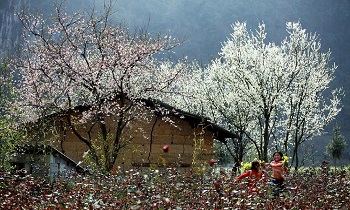
Culture of Thai people in Mai Chau
The culture of Thai people in Mai Chau - The Thai language belongs to the Tay-Thai Group. They have a valuable legacy of myths, legends, ancient tales, versed stories, and folk songs.
Production activities
Early in their history, the Thai adopted wet rice cultivation, using suitable irrational networks. The work can be summarized in the Thai saying “muong-phat-lai-lin” (which means digging of canals, consolidating of banks, guiding water through obstacles, and fixing water gutters) in the fields.

Culture of Thai people in Mai Chau
While the Thai once grew only one sticky rice crop a year, nowadays they have converted to two crops of ordinary rice. They also cultivate wideness fields, where they grow rice, corn, and subsidiary crops, especially cotton, indigo and mulberry for cloth weaving.
Social organization
The original social structure is called ban muong, also known as the phia tao regime. The Thai lineage is called Dam. Each person has three key linear relationships: Ai Noong (every born from a common fourth-generation ancestor); Lung Tay (every male member of the wife’s family throughout generations); and Nhinh Xao (every male member of the sons-in-law)
Marriage
In the past, the Thai respected the selling and buying of marriage and the son-in-law’s staying with the girl’s family. To marry a husband, the girl’s family needs to take two basic steps:
- Up marriage (dong khun): means the introduction and bringing of the son-in-law to live with the girl’s family, which is a step to test his personality and hard work. The Black Thai women generally adopt the custom of wearing their hair in as bun or chignon immediately after this first wedding ceremony. The son-in-law will stay at his wife’s home for 8 to 12 years.
- Down marriage (dong long): the bringing of the couple and their family.
Birth
Women give birth in the seated position. The placenta is put into a bamboo cylinder and hung on a branch in the forest. The mother is warmed by the fire, fed rice using a bamboo tube, and must abstain from certain foods for a month. The bamboo tubes are hung on a tree branch. There are rituals to educate the child in gender-specific work and a Lung Tay is invited to the house to name the baby.
Funerals
Basically, there are two steps in a funeral:
- Pong: the bringing of offerings o the deceased and bringing the deceased to the forest for burial (White Thai)
- Xong: Calling the spirit to come back and live in the section of the house reserved for the worshiping of ancestors.
New House: Showing the host his new house, the Lung Ta kindles a new fire. In celebrating a new house, people carry out spiritual rites on the spot, reading spiritual texts to drive away bad lucks and to bring good lucks, and to worship ancestors.
Festivals
The Black Thai worship their ancestors on the 7th and 8th month of the Lunar Year. The White Thai also celebrate the New Year according to the lunar calendar. Villagers also worship the gods of the land, mountain, water and the soul of the central post of the village.

The culture of Thai people in Mai Chau
Calendar
The Thai calendar follows the ancient horoscope or cosmology (which contains 12 key animals) like the lunar calendar. But the Black Thai’s calendar has a time difference of six months.
Education
The Thai have their own Sanskrit-style writing system. Their language is taught orally. The Thai have many ancient written works on their history, traditions, customary laws, and literature.
Artistic activities
The Thai perform their Xoe dance and play many kinds of flutes. They sing out verses and vivid alternate songs.
Entertainment
Thai popular games include con throwing, tug-of-war, horse racing, boat cruising, archery, xoe dance, spinning top, and mak le balls. There are many other games for kids.










